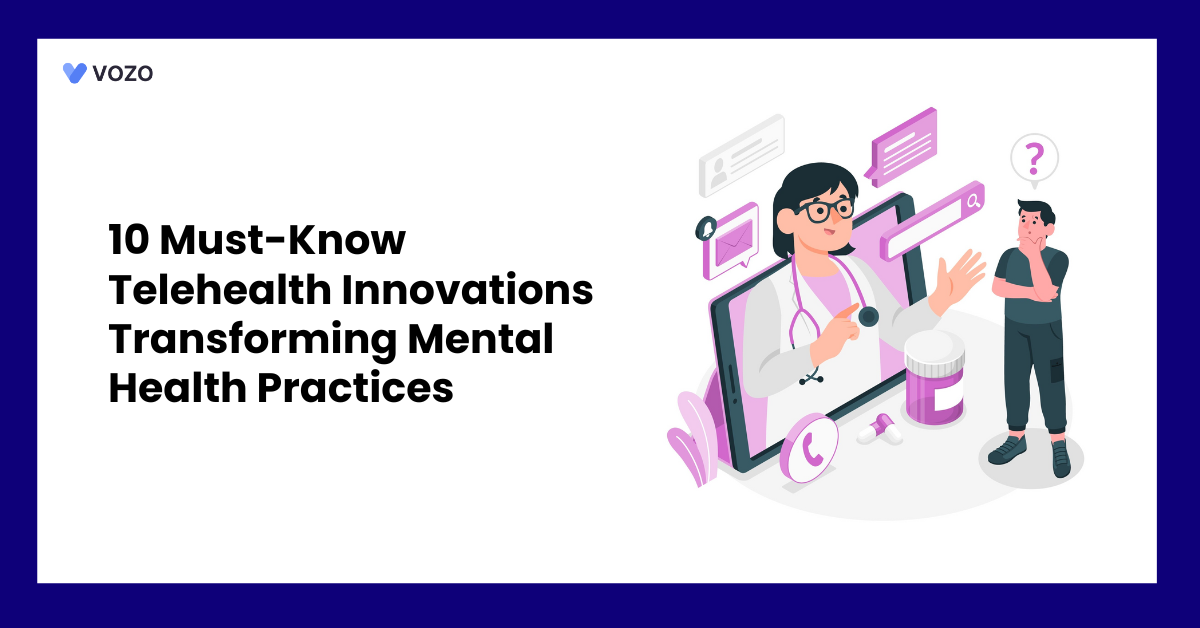10 Must-Know Telehealth Innovations Transforming Mental Health Practices
Telehealth has fundamentally changed mental health care by breaking down geographic barriers and improving efficiency for providers. In the US, clinicians now leverage a range of digital tools that go far beyond simple video visits, from AI-driven apps to immersive VR experiences.
These ten innovations are reshaping how professionals diagnose, treat, and monitor patients, while optimizing workflows. As demand for virtual behavioral health care grows, staying up to date with these tools ensures best practices and better patient outcomes.
Related: Best Strategies to Enhance Telehealth Experience for Mental Health Clients
10 Telehealth Innovations that Transform Mental Health Practices
1. Advanced Telepsychiatry Platforms
Telepsychiatry has evolved into robust platforms designed for mental health specialists. Modern systems integrate secure, HIPAA-compliant video with features like e-prescribing, real-time note-taking, and virtual whiteboards, supporting everything from medication management to psychotherapy.
These platforms expand access by connecting patients in rural or underserved areas with specialists in urban centers. Enhanced functionality, such as multi-party calls for family therapy or collaborative care conferencing with primary care providers, also streamlines coordination and follow-up.
Overall, advanced telepsychiatry tools improve patient reach and allow clinicians to maintain continuity of care across different settings.
2. AI-Powered Chatbots and Virtual Assistants
AI-driven chatbots and virtual assistants are becoming allies in mental health care, offering immediate support and automating routine tasks.
Patient-facing bots (such as conversational apps for mood tracking or cognitive behavioral exercises) provide 24/7 check-ins, triage symptoms, and encourage adherence between visits. On the provider side,
- AI assistants can schedule appointments
- Manage intake forms
- Send reminders, freeing clinicians to focus on therapy.
While these tools do not replace human therapists, they supplement care by keeping patients engaged in therapeutic activities and helping to detect warning signs early. As natural language processing improves, such assistants are expected to play larger roles in screening and even crisis intervention.
3. Digital Therapeutics and Mobile Health Apps
Evidence-based digital therapeutics, software programs that deliver clinically validated interventions, are rapidly transforming mental health treatment. In the US, several prescription-based therapeutic apps (some FDA-authorized for insomnia and substance use disorders) have gained attention.
Clinicians now often recommend smartphone apps that guide patients through structured programs (for example, digital cognitive-behavioral therapy or mindfulness exercises) and share progress with the clinician. These tools augment traditional therapy by reinforcing skills between sessions and enabling remote monitoring of symptoms. Over time, reimbursement pathways are emerging for certain digital treatments, further integrating them into standard care.
4. Virtual and Augmented Reality (VR/AR) Therapies
Immersive VR and AR technologies are being adopted as novel therapeutic modalities. For exposure-based therapies (for example, treating phobias, PTSD, or anxiety disorders), VR creates controlled virtual scenarios that a therapist can guide, potentially achieving faster progress than in vivo exposure. Augmented reality can overlay therapeutic content on a user’s real environment, such as guided meditation visuals or interactive skills-training tasks.
Early studies show promise for using VR/AR to engage patients and expand treatment options, especially among younger or tech-savvy populations. Although cost and training remain considerations, these tools are on track to become more mainstream in specialized mental health settings.
5. Wearable Devices and Remote Monitoring
Wearable technology and remote monitoring apps provide continuous insight into a patient’s physiological state and daily behavior. Smartwatches and fitness trackers measure sleep patterns, heart rate variability, and activity levels – metrics that often correlate with stress, mood, or sleep quality.
By sharing this data through integrated telehealth apps or patient portals, clinicians can track trends (for example, detecting signs of mood swings or deteriorating sleep) and personalize care plans.
Some platforms also use mobile sensors or digital diaries to monitor medication adherence or side effects. This ongoing data collection supports proactive management of conditions like bipolar disorder, anxiety, and chronic stress, enabling timely intervention.
6. Integrated Telehealth-EHR Systems
New EHR and telehealth platforms specialized for behavioral health bring all aspects of care into one workflow. These systems unify video visits, scheduling, billing, and clinical documentation in a single interface customized for therapists and psychiatrists.
Built-in features often include therapy note templates, standardized assessment scales, and outcome trackers. Such integration reduces duplicate data entry and administrative overhead – for example, after a video session a clinician can immediately access patient history, update notes, e-prescribe, and send follow-up reminders without switching apps. By streamlining workflow, these systems save time and help practices manage larger patient panels effectively.
7. AI-Assisted Documentation and Workflow Tools
Artificial intelligence is also reshaping clinical workflow behind the scenes. AI-assisted documentation tools can transcribe and summarize teletherapy sessions in real time, automatically generating draft clinical notes or suggested diagnosis codes.
This significantly reduces the clerical burden of manual charting. Other AI tools can analyze session recordings to identify themes or sentiment, while machine learning algorithms optimize scheduling (for example, by predicting no-show risk) and flag patients due for follow-up. These workflow enhancements not only save time for clinicians but also improve compliance and billing accuracy.
8. Online Group Therapy and Peer Support Platforms
Group therapy and peer support have also gone digital, expanding access to community-based care. Many telehealth services now offer secure group video sessions led by a therapist, which can be more affordable and provide social connection.
Online support communities and guided peer groups (for issues like depression, PTSD, or chronic illness) are integrated into platforms, sometimes with moderation by mental health professionals. These virtual groups can
- Use breakout rooms
- Group chats
- Interactive activities to foster engagement and shared learning.
By enabling group participation remotely, these innovations help address loneliness and provide scalable therapy options while still allowing clinicians to oversee the process.
9. Measurement-Based Care and Outcome Tracking
Telehealth platforms increasingly embed tools for measurement-based care, where standardized assessments are used routinely to guide treatment. Electronic versions of tools like the PHQ-9 or GAD-7 can be administered through patient portals or apps before each visit.
The software then tracks scores over time, alerting providers to improving or worsening trends. Dashboards that visualize these outcomes help clinicians adjust treatments or medications promptly. By quantifying progress and involving patients in tracking their symptoms, these tools reinforce evidence-based practice and enhance engagement.
Related: How AI-Powered Symptom Checkers Are Improving Telehealth Consultation
10. Asynchronous Telehealth and Hybrid Care Models
Asynchronous telehealth and hybrid care models offer greater flexibility for patients and providers. Secure messaging, email check-ins, or digital homework assignments let patients communicate updates or complete therapy exercises on their schedule, which the clinician can review later. Platforms may include asynchronous intake forms or video checklists, reducing in-session administrative tasks.
Many practices now combine in-person and virtual visits – for example, conducting initial evaluations face-to-face and then switching to video follow-ups. This blended approach not only optimizes scheduling and access (shorter remote visits can save office space), but also maintains a human connection by allowing occasional in-person meetings as needed.
Vozo Cloud EHR With Built-In Telehealth Platform
If you are searching for the best EHR system for your healthcare practice, Vozo EHR can be your go-to choice. Our comprehensive EHR solution lets you focus more on patient care while carrying all the burdens and simplifying them.
- Vozo Cloud EHR’s cost-effective cloud subscription benefits all levels of practice.
- Our feature-rich EHR helps you rectify mistakes efficiently and speed up the process.
- Vozo Specialty EHR resonates with specialty practice needs and requirements.
- Our expert technical team gets you covered 24/7 if any needs arise.
Our EHR System continues to scale as your healthcare practice grows to improve the user experience.
The Vozo Customized EHR solution benefits your healthcare practice by:
- Streamlining the administrative process
- Improving workflow efficiency
- Reducing proneness to errors
- Manages all the patients’ records in one place
- Offers greater efficiency and cost savings across the board.
Our specialty-specific tools, like scheduling, patient portals, lab integration, cloud hosting, and more, meet the specific needs and requirements of your healthcare practice.
“Embrace Vozo EHR to Reduce Your Burdens and Enhance Patient Care”
About the author

With more than 4 years of experience in the dynamic healthcare technology landscape, Sid specializes in crafting compelling content on topics including EHR/EMR, patient portals, healthcare automation, remote patient monitoring, and health information exchange. His expertise lies in translating cutting-edge innovations and intricate topics into engaging narratives that resonate with diverse audiences.













